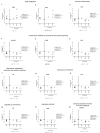Differential Gene Expression of Subcutaneous Adipose Tissue among Lean, Obese, and after RYGB (Different Timepoints): Systematic Review and Analysis
- PMID: 36432612
- PMCID: PMC9693162
- DOI: 10.3390/nu14224925
Differential Gene Expression of Subcutaneous Adipose Tissue among Lean, Obese, and after RYGB (Different Timepoints): Systematic Review and Analysis
Abstract
The main roles of adipose tissue include triglycerides storage and adipokine secretion, which regulate energy balance and inflammation status. In obesity, adipocyte dysfunction leads to proinflammatory cytokine production and insulin resistance. Bariatric surgery is the most effective treatment for obesity, the gold-standard technique being Roux-en-Y gastric bypass (RYGB). Since metabolic improvements after RYGB are clear, a better understanding of adipose tissue molecular modifications could be derived from this study. Thus, the aim of this systematic review was to find differentially expressed genes in subcutaneous adipose tissue of lean, obese and post-RYGB (distinct timepoints). To address this objective, publications from 2015-2022 reporting gene expression (candidate genes or transcriptomic approach) of subcutaneous adipose tissue from lean and obese individuals before and after RGYB were searched in PubMed, Elsevier, and Springer Link. Excluded publications were reviews, studies analyzing serum, other types of tissues, or bariatric procedures. A risk-of-bias summary was created for each paper using Robvis, to finally include 17 studies. Differentially expressed genes in post-RYGB vs. obese and lean vs. obese were obtained and the intersection among these groups was used for analysis and gene classification by metabolic pathway. Results showed that the lean state as well as the post-RYGB is similar in terms of increased expression of insulin-sensitizing molecules, inducing lipogenesis over lipolysis and downregulating leukocyte activation, cytokine production and other factors that promote inflammation. Thus, massive weight loss and metabolic improvements after RYGB are accompanied by gene expression modifications reverting the "adipocyte dysfunction" phenomenon observed in obesity conditions.
Keywords: RYGB; gene candidate; gene expression; obesity; subcutaneous adipose tissue; transcriptome.
Conflict of interest statement
The authors declare no conflict of interest. The funders had no role in the design of the study; in the collection, analyses, or interpretation of data; in the writing of the manuscript; or in the decision to publish the results.
Figures







Similar articles
-
Surgical, metabolic, and prognostic outcomes for Roux-en-Y gastric bypass versus sleeve gastrectomy: a systematic review.Surg Obes Relat Dis. 2021 Dec;17(12):2097-2106. doi: 10.1016/j.soard.2021.06.020. Epub 2021 Jul 7. Surg Obes Relat Dis. 2021. PMID: 34642101
-
Comparison of metabolic outcomes in patients undergoing laparoscopic roux-en-Y gastric bypass versus sleeve gastrectomy - a systematic review and meta-analysis of randomised controlled trials.Swiss Med Wkly. 2018 Jul 5;148:w14633. doi: 10.57187/smw.2018.14633. eCollection 2018. Swiss Med Wkly. 2018. PMID: 30035801
-
Interventions for promoting habitual exercise in people living with and beyond cancer.Cochrane Database Syst Rev. 2018 Sep 19;9(9):CD010192. doi: 10.1002/14651858.CD010192.pub3. Cochrane Database Syst Rev. 2018. PMID: 30229557 Free PMC article.
-
Cost-effectiveness of using prognostic information to select women with breast cancer for adjuvant systemic therapy.Health Technol Assess. 2006 Sep;10(34):iii-iv, ix-xi, 1-204. doi: 10.3310/hta10340. Health Technol Assess. 2006. PMID: 16959170
-
Home treatment for mental health problems: a systematic review.Health Technol Assess. 2001;5(15):1-139. doi: 10.3310/hta5150. Health Technol Assess. 2001. PMID: 11532236
Cited by
-
Single-nucleus transcriptomics of epicardial adipose tissue from females reveals exercise control of innate and adaptive immune cells.bioRxiv [Preprint]. 2023 Nov 5:2023.11.02.565385. doi: 10.1101/2023.11.02.565385. bioRxiv. 2023. Update in: Cell Commun Signal. 2024 Apr 26;22(1):243. doi: 10.1186/s12964-024-01587-w. PMID: 37961306 Free PMC article. Updated. Preprint.
-
The differential expression of adipose tissue genes in short, medium and long-term periods after bariatric surgery.Sci Rep. 2024 Aug 28;14(1):19991. doi: 10.1038/s41598-024-70629-7. Sci Rep. 2024. PMID: 39198660 Free PMC article.
-
Single-nucleus transcriptomics of epicardial adipose tissue from female pigs reveals effects of exercise training on resident innate and adaptive immune cells.Cell Commun Signal. 2024 Apr 26;22(1):243. doi: 10.1186/s12964-024-01587-w. Cell Commun Signal. 2024. PMID: 38671495 Free PMC article.
-
EFFICACY AND SAFETY OF ONE ANASTOMOSIS GASTRIC BYPASS IN SURGICAL TREATMENT OF OBESITY: SYSTEMATIC REVIEW AND META-ANALYSIS OF RANDOMIZED CONTROLLED TRIALS.Arq Bras Cir Dig. 2024 Aug 30;37:e1814. doi: 10.1590/0102-6720202400021e1814. eCollection 2024. Arq Bras Cir Dig. 2024. PMID: 39230117 Free PMC article.
-
Initial Weight Loss, Anthropometric Parameters, and Proinflammatory Transcript Levels in Patients with Class I Obesity.Biomedicines. 2023 Aug 18;11(8):2304. doi: 10.3390/biomedicines11082304. Biomedicines. 2023. PMID: 37626800 Free PMC article.
References
-
- OMS Obesidad y Sobrepeso. [(accessed on 16 January 2022)]. Available online: https://www.who.int/es/news-room/fact-sheets/detail/obesity-and-overweight.
Publication types
MeSH terms
Substances
Grants and funding
- PAPIIT IA203919/Proyectos de Investigación e Innovación Tecnológica/Dirección General de Asuntos del Personal Académico (DGAPA)/Universidad Nacional Autónoma de México (UNAM)
- 2022/División de Investigación de la Facultad de Medicina, UNAM
- HIM2018-028FF/Hospital Infantil de México Federico Gómez
- N/A/División de Investigación de la Facultad de Medicina, UNAM
- N/A/Dirección General de Asuntos del Personal Académico (DGAPA)
LinkOut - more resources
Full Text Sources
Medical
Research Materials

